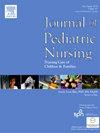Assessing the use of the distress and discomfort assessment tool (DisDAT) in a pediatric population
IF 2.1
4区 医学
Q2 NURSING
Journal of Pediatric Nursing-Nursing Care of Children & Families
Pub Date : 2025-05-05
DOI:10.1016/j.pedn.2025.04.026
引用次数: 0
Abstract
Purpose
The purpose of this study is to assess the effectiveness and usefulness of the DisDAT form in a pediatric population.
Design and methods
This is a mixed-methods study using content analysis of completed DisDAT forms as well as thematic analysis of semi-structured interviews to assess the use of the DisDAT to identify signs of distress across multiple domains of patient behavior and appearance.
Results
We found that, regardless of the perceived difficulty of using the form, caregivers universally found it to be worthwhile and useful. Based on interview findings, caregivers felt that the DisDAT enhanced their ability to communicate with healthcare providers. Quantitative analysis found that the DisDAT was equally effective at prompting cues associated with contentment and with distress.
Conclusions
Building on prior research conducted in adults, the DisDAT is an effective tool to communicate distress signals for nonspeaking pediatric patients.
Practice implications
The DisDAT is a useful adjunct to clinical practice in pediatric patients with severe communication impairments.
评估儿童人群窘迫和不适评估工具(不屑于)的使用情况
目的本研究的目的是评估在儿科人群中使用不屑于量表的有效性和有用性。设计和方法这是一项混合方法研究,使用已完成的不屑于测试表格的内容分析以及半结构化访谈的主题分析来评估不屑于测试在患者行为和外表的多个领域中识别痛苦迹象的使用。结果我们发现,不管使用表格的难度如何,护理人员普遍认为它是值得和有用的。根据访谈结果,护理人员认为不屑于提高他们与医疗保健提供者沟通的能力。定量分析发现,distat在提示与满足和痛苦相关的线索方面同样有效。基于先前在成人中进行的研究,不屑于是一种有效的工具来传达不说话的儿科患者的求救信号。实践意义在患有严重沟通障碍的儿童患者中,diat是一种有用的临床辅助手段。
本文章由计算机程序翻译,如有差异,请以英文原文为准。
求助全文
约1分钟内获得全文
求助全文
来源期刊

Journal of Pediatric Nursing-Nursing Care of Children & Families
NURSING-PEDIATRICS
CiteScore
3.70
自引率
8.30%
发文量
291
审稿时长
65 days
期刊介绍:
Official Journal of the Society of Pediatric Nurses and the Pediatric Endocrinology Nursing Society (PENS)
The Journal of Pediatric Nursing: Nursing Care of Children and Families (JPN) is interested in publishing evidence-based practice, quality improvement, theory, and research papers on a variety of topics from US and international authors. JPN is the official journal of the Society of Pediatric Nurses and the Pediatric Endocrinology Nursing Society. Cecily L. Betz, PhD, RN, FAAN is the Founder and Editor in Chief.
Journal content covers the life span from birth to adolescence. Submissions should be pertinent to the nursing care needs of healthy and ill infants, children, and adolescents, addressing their biopsychosocial needs. JPN also features the following regular columns for which authors may submit brief papers: Hot Topics and Technology.
 求助内容:
求助内容: 应助结果提醒方式:
应助结果提醒方式:


